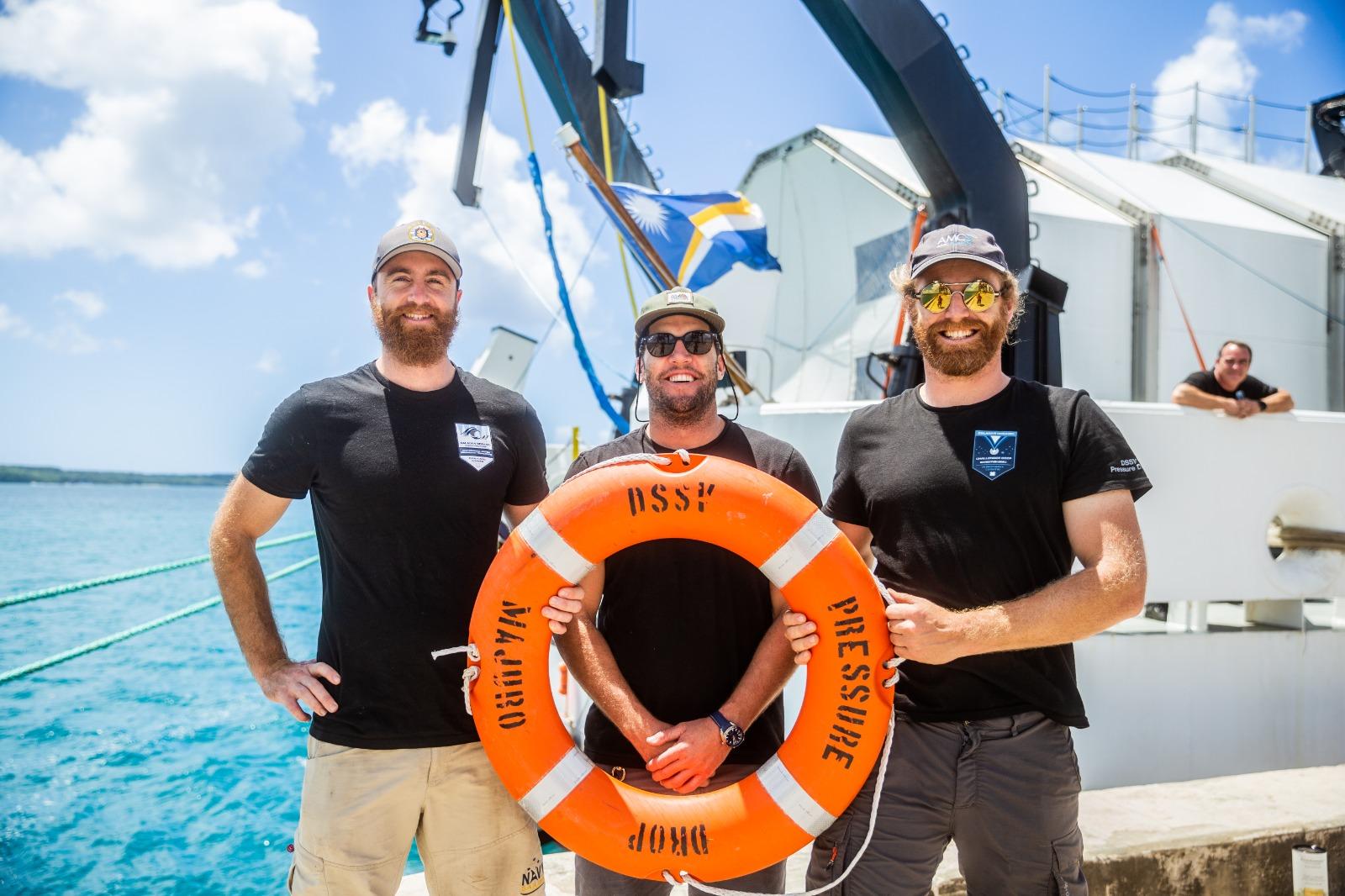Tales from the deep
AMC Search's Reuben Kent joins expedition to the Challenger Deep, the deepest point on Earth!
March 26, 2021

AMC Search's very own AUV Engineer Reuben Kent (right side of picture) has just returned from the Mariana Trench where he took part in the latest Caladan Oceanic mission to the Challenger Deep, the deepest point on Earth.
From his hotel quarantine room in Sydney, Reuben has penned this personal reflection of the mission and the role he played in the mission...
I was invited to participate in the campaign as a mission specialist with an acoustics communication and support role. I joined autonomous systems engineer James Keane and Caladan Oceanic Sub Pilot Tim McDonald, both are AMC alumni.
We joined the DSSV Pressure Drop in Guam on February the 23rd. After several days of training and familiarisation we set off on an approximately 24-hour steam to the dive site. The ocean was a surreal vibrant blue. It was clear to all onboard that we were in very deep water!
Onsite the weather was a steady force 3 & 4 every day, it never changed. Launch and Recovery operations involved two support boats, the DSSV Pressure Drop’s A-frame and knuckle boom crane, a swimmer and almost the full complement of crew.
It was a serious deal lowering each item overboard in the heaving swell, then trying to transit crew onboard. A task that can only be possible with a highly competent and focused crew.
A typical dive day started at 03:30-04:00 with the deployment of scientific payload landers (At 23:30 we will be back to pick them up). The goal being that the landers will descend to the bottom and be stationary by the time the submersible Limiting Factor (LF) is in the water and attempting to navigate using their position. LF enters the water around 06:00-07:00 and as soon as the surface loses comms with the sub pilot the operations are handed over to “Control”.
This is the point that James and I step in with our acoustic communications. We track the submersible using the same techniques used to monitor AMC’s own AUV’s. It takes approximately 3-hours for the sub to descend. Once on bottom there is a faint radio call from the LF:
“SURFACE THIS IS LF, LIFE SUPPORT GOOD, ON BOTTOM, REPEAT ON BOTTOM.”
A cheer would ring out amongst the crew huddled in the dry lab, the home of Control. The LF can then spend up to 4-hours on the seafloor. On the third dive with Co-Pilot Hamish Harding the LF broke the world record for bottom time, 4 hours and 15 minuets!
The submariners typically return to the surface between 18:00-20:00 and many recoveries are done in darkness. It is another all-hands operation and a precarious task as the sub must be towed and positioned in place behind the ship before recovery. Once it is partially lifted clear of the water the LF hatch is pumped out and our deep-sea explorers are free to disembark.
The submariners are welcomed back onboard and always have a tale to tell! From vertical rock walls to stuck manipulators and broken thruster brackets. On several dives they had to navigate around a mysterious suspended cable. Suspected to have been abandon on earlier campaigns by other, tethered vehicles. They describe the bottom as a surreal moon like surface. Once safely on deck there is a quick photoshoot and they generally disappear for a nice hot meal and some rest.
Between dives James and I helped with maintenance of the sub, changing out batteries/sensors and repairing damaged components. We also ensured that data collected on mission was distributed amongst the scientific community attached to the vessel and that all sensors were functioning correctly.
Across the series of dives, we collected samples of bottom water, small shrimp like animals (Living at 10,920-meters!!! how do they handle the pressure?) sediment cores and clumps of compacted silt.
Tragically we also found traces of micro plastics in the water.
To date more people have visited the moon than have visited the bottom of the ocean.
Overall, it was an amazing experience to be part of and summed up perfectly by the Expedition Leader Rob McCallum’s quote, "Ordinary people doing extraordinary things!".
